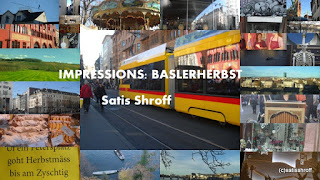THE AUTUMN FAIR IN SWITZERLAND (Satis Shroff)
THE AUTUMN FAIR IN SWITZERLAND (Satis
Shroff)
IT was a beautiful afternoon in November. Friendly
fluffy clouds broke the steel blue sky over the Black Forest, as the sleek,
white ICE train sped towards Basle (Switzerland) from Freiburg (Germany). The
train dashed across the autumnal landscape with yellow, orange and brown leaves
on the trees, fields and meadows. The blonde weather frog had said that a mild
air-mass would block the colder front, and the sun which would make its heat
felt when the mist had cleared.
In the distance
you could discern the Vosges (France) as faintly blue ranges. If you want to
have a quick meal in the train run by the German Railways, you have a choice
between various vegetables with artechocks and curcuma rice and focaccio or
tofu. Or a kasseler with sauerkraut and salted potatoes. Another possibility
would be Dörrpflaumen-Füllung, wirsing served with herbal noodles. I’ve tried
the food often on the way to Amsterdam or the North Sea and I’d recommend it.
After the short-cut via the 14km Katzenberg
tunnel the train pulled up in the Badische
Bahnhof (Basle).
Basle lies in the three-country triangle:
France, Germany and Switzerland, and is a cosmopolitan town, conscious of its
customs and traditions and can be reached via Euroairpot
Basle-Mulhous-Freiburg. It has famous chemical and pharmaceutical industries
(Novartis, Roche) and is known for electro-technique, textile and food
industry, and its insurance and banks. Along the Small Basle river bank you can
see the olde town and you can go for a walk
upto the Rhine harbor. In summer this river bank is visited by a great many
people who jump into the river to cool themselves.
It’s autumn now,
and the Rhine bank is the place where a lot of Basler sun, watch the Rhine
traffic, birds flying by. You can close your eyes and enjoy the caressing rays
of the afternoon and evening sun.
Basle is divided
into Big and Small Basle. The old part
of the town belongs to Big Basle, where most of the administrative buildings
are located. In Small Basle you have the industrial area and the fair (Messe)
on the right bank of the Rhine. The middle bridge connects Big and Small Basle.
There are beautiful and rich shops along Small Basle’s Claraplatz, and if you
prefer an exclusive Swiss eating place then it’s the Wirtshaus zur Säge.
You go through
the city, past the Helvetia statue to the right of the Rhine bridge and head
for the town council and the victual market, then up a flight of steep stairs
along a narrow lane. There are many such lanes that give Basle its romantic
character.
Since it was a Saturday, pedestrians were
pouring into the streets. The shops were open and people were making use of their
weekend. There were a lot of goodies to buy in the stands of the 545th
Basler Autumn Fair, which was billed as the biggest and oldest entertainment
fair of Switzerland. The fair was all over Basle: Riehenring, Messeplatz,
Petersplatz along the Hääfelimäärt. The latter, a traditional pottery market,
was interesting with self-made cups and plates and home decorations in gaudy
but aesthetic colours.
Young and
elderly Swiss, French, German and people from Arabia, Africa, Asia were out to
enjoy the Basler leckerli and try out international cuisine, buy textiles and
leather wear and have joy rides with their kids in the ferris-wheel Vienna
Prater ghost-ride, swing up, auto-scooter, super chaos, caroussel, Coco Bongo,
flying carpets, Pegasus, Crazy Clown, enterprise, fun house, jungle street,
snow dream, sky flyer crazy carpet etc.
Basle became a
part of the German Reich in 1033. In 1348 it was rampaged by the plague, and
Basle tried to get rid of this infectious disease by means of the persecution
of its Jewish citizens (Judenprogrom). In 1356 the town was destroyed by an earthquake.
The market-place
is a very lively area and you see the local Swiss vendors selling seasonal
vegetables and fruit, flowers, sausages and a good many sweet, delicious
leckerlis. The town council has a conspicuous scarlet façade. The middle part of
has arcades built by Ruman Faesch 1504-1521 in Burgunder Late Gothic style, and
there’s a clock constructed by master Wilhelm dating back to 1512. The façade
figures of the town great council was painted originally by Hans Bock. In the
Great Council Hall there are the impressive shields of the 15 Swiss cantons. If
you want to do the sights of Basle, it takes 50 minutes with bus number 36 from
the Schiffslände towards Kleinhühningen. You can return with tram number 8.
Basle’s
university was founded in 1460 and the town was initially known for printing
and publishing industries. Basle fought against the Habsburger and the krieg
ended in 1501. Basle’s university became the centre of humanism through Erasmus
von Rotterdam, who lived in the Swiss town since 1535. Another of Basle’s
famous personalities was the physician
Paracelsus (1526-1528). Other famous citizens were the mathematicians
Jakob and Johann Bernoulli. And, of course, the philologist-cum-philosopher
Friedrich Nietsche.



Kommentare
Kommentar veröffentlichen